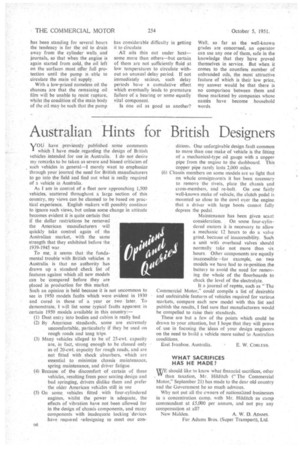Australian Hints for British Designers
Page 46

If you've noticed an error in this article please click here to report it so we can fix it.
VOU have previously published some comments I which I have made regarding the design of British vehicles intended for use in Australia. I do not desire my remarks to be taken as severe and biased criticism of such vehicles in general—I merely want to emphasize through your journal the need for British manufacturers to go into the field and find out what is really required of a vehicle in Australia.
As If am in control of a fleet now approaching 1,500 vehicles, scattered throughout a large section of this country, my views can be claimed to be based on practical experience. English makers will possibly continue to ignore such views, but unless some change in attitude becomes evident it is quite certain that if the dollar restrictions be removed the American manufacturers will quickly take control again of the Australian market, with the same strength that they exhibited before the 1939-1945 war,
To me, it seems that• the fundamental trouble with British vehicles Australia is that no authority has drawn up a standard check list of features against which all new models can be compared before they are placed in production for this market. Such an opinion is held because it is not uncommon to see in 1950 models faults which were evident in 1930 and cured in those of a year or two later. To demonstrate, I will list some typical faults apparent in certain 1950 models available in this country:—
(1) Dust entry into bodies and cabins is really bad.
(2) By American standards, some are extremely uncomfortable, particularly if they be used on rough roads and tong trips.
(3) Many vehicles alleged to be of 25-cwt. capacity are, in fact, strong enough to be classed only as of 20-cwt. capacity for rough roads, and are not fitted with shock absorbers, which are essential to minimize chassis maintenance, spring maintenance, and driver fatigue.
(4) Because of the discomfort of certain of these vehicles, resulting from poor seating design and bad springing, drivers dislike them and prefer • the older American veh:cles still in use (5) On some vehicles fitted with four-eylindered
engines, whilst the power is adequate, the effects of vibration have not been allowed for in the design of chassis components, and many components with inadequate locking -devices have requited redesigning to meet our eon
ditions. One unforgivable design fault common to more than one make of vehicle is the fitting of a mechanical-type oil gauge with a copper pipe from the engine to the dashboard. This copper pipe rarely lasts 2,000 miles. (6) Chassis members on some Models are so light that on whole consignments it has been necessary to remove the rivets, plate the chassis and cross-members, and re-bolt. On one fairly well-known make of vehicle, the clutch pedal is mounted so close to the cowl oyer the engine that a driver with large boots cannot fully depress the pedal.
Maintenance has been given scant
consideration. On some four-cylindered motors it is necessary to allow a mechanic 12 hours to do a valve grind, because of inaccessibility. Such a unit with overhead valves should normally take not more than six hours. Other components are equally inaccessible--for example, on two models we have had to re-position the bane' y to avoid the need for removing the whole of the floorboards to check the level of the •electrolyte.
It a journal of reptite, such as "The Commercial Motor," could compile a list of desirable and undesirable features of vehicles required for various markets, compare each new model with this list and publish the results, I feel sure that manufacturers would be compelled to raise their standards.
These are but a few of the points which could be drawn to your attention, but I hope that they will prove of • use in focusing the ideas of your design engineers on the need to build a vehicle more suited to Australian conditions.
East Ivanhoe, Australia. E. W. CORLESS.
WHAT SACRIFICES HAS HE MADE?
WE should like to know what financial sacrifices, other " than taxation, Mr. Hild itch ("The Commercial Motor," September 21) has made to the dear old country and the Government he so much admires.
Why not out all the owners of nationalized businesses in a concentration camp, with Mr. Hilditch as camp commandant at £5,0.00 per annum, and not pay any compensation at all?
New Maiden. A. W. D. ADAMS. For Adams Bros. (Super Transport), Ltd.
































































































